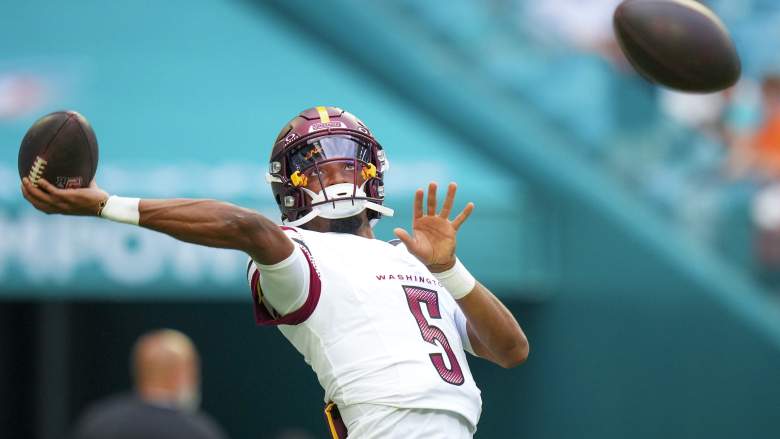
Getty Jayden Daniels still needs to pass a key NFL test for the Washington Commanders.
s
o far, so good for the Washington Commanders and Jayden Daniels, who’s already won the job as the team’s starting quarterback, but the No. 2 pick in the 2024 NFL draft still hasn’t passed one key test.
The test concerns the type of passing Daniels needs to do to prove he can adapt to the pro game. Specifically, dropback passing, something the former Heisman Trophy winner has done precious little of during preseason.
It’s a potential issue spotted by Ian Hartitz of Fantasy Life. He broke down what the Commanders’ offense has looked like with Daniels at the controls and former Arizona Cardinals head coach Kliff Kingsbury calling plays.
Hartitz noticed Washington has relied on run-pass option plays instead of traditional dropbacks: “Only the Eagles (22.8%) and Panthers (22.2%) have run a higher percentage of snaps featuring a run-pass-option (RPO) than the Commanders (22%). Kliff’s Arizona offenses ranked third (17.1%) in RPO rate.”
Leaning on RPOs worked briefly for Washington with another dual-threat, second-overall pick, Robert Griffin III. Yet. RG3 came unstuck after a record-setting rookie campaign, largely thanks to injuries, but also because he didn’t make strides as a traditional, pro-style passer.
The Commanders must avoid a similar fate for Daniels.
Commanders Need Dropback Test for Jayden Daniels
Having one more exhibition game, against the New England Patriots on Sunday, August 25, gives the Commanders ample opportunities to test Daniels’ dropback aptitude. It’ll be important to know exactly how far along the former LSU star is in his development this close to the regular-season opener against the Tampa Bay Buccaneers on Sunday, September 8.
Fortunately, there have been brief glimpses of what Daniels can do without a play fake or a moving pocket. Like when he made this quick throw to Terry McLaurin against the Miami Dolphins in Week 2, highlighted by Josh Edwards of CBS Sports.
The Commanders need to know Daniels can stand tall amid pressure and exploit coverage when defenses know he has to pass. When there’s less of a threat he’ll take off and run.
Griffin couldn’t do those things once the knee injury the 2012 NFL Offensive Rookie of the Year suffered against the Seattle Seahawks in the playoffs took away his mobility. Lacking breakaway speed as a runner forced Griffin to stay in the pocket more often, and his total QBR in those situations dropped to 49.6 during his second season, per ESPN Stats & Info.
The same source detailed how RG3 also had a league-low 8.5 QBR “on passes more than 15 yards downfield this season.” Exactly the kind of throws quarterbacks need to remain stationary to deliver and usually attempt in obvious passing and long-yardage situations.
RPOs and a fast pace helped Griffin thrive early, and they could do the same for Daniels, but the Commanders can’t be overly protective of their would-be franchise QB.
Kliff Kingsbury’s Protecting Jayde Daniels With Scheme
The Commanders need Daniels to start right away and inspire a quick turnaround under new head coach Dan Quinn. So it makes sense for coordinator Kingsbury to do all he can to craft an offense designed around the rookie’s core strengths.
That’s meant fake handoffs to force defenses to play run and minimise pressure. It’s also meant clearing the underneath passing lanes to give Daniels easy reads and quick throws.
A great example of all this theory in practice occurred against the Dolphins on a play highlighted by Ted Nguyen of The Athletic. Daniels faked to Austin Ekeler, before quickly connecting with tight end John Bates behind linebackers stepping up to attack a perceived run.
Kingsbury is also helping Daniels by combining fakes and easy reads with a rapid pace, per Hartitz: “Always known for featuring a quick pace (league-high 34.6% no-huddle rate with the Cardinals), Washington has a ridiculous no-huddle rate of 56.7% at the moment – the Steelers are in second place at 13%.”
Going no-huddle this often and this swiftly means Daniels is usually throwing against gassed, base defense personnel. Not against extra defensive-back packages constructed to stop the pass.
This offense has advantages, but no pro quarterback will thrive on RPOs and hurry-up football forever. The Commanders ultimately need Daniels to prove he can stay in the pocket and beat defenses with his arm when they know he’s going to try.
Developing the 23-year-old’s dropback game is the best way to make it happen. It’ll also limit how often Daniels runs and exposes himself to hits, something that’s already a concern.
Fortunately, the Commanders still have enough prep time to test Daniels in more pro-like scenarios.

Comments